MIAMI CIRCLE RESOURCES
History of the discovery and preservation of the circle, a battle won by science, culture and activism
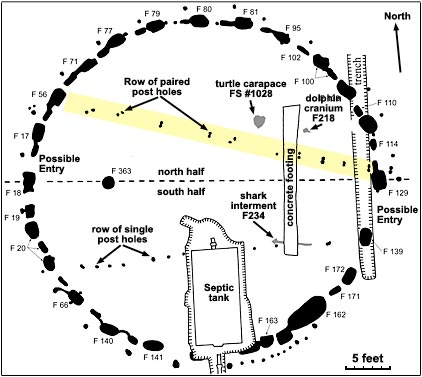

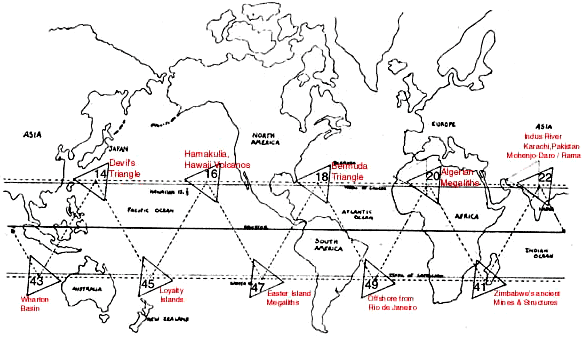

SITE DISCOVERY
The Miami Circle was discovered in August/September, 1998, during routine archaeo-logical investigations conducted at the site of six low-rise, 1950-era apartment buildings (Brickell Point Apartments), which were razed to make way for construction of two high-rise apartment towers.
Surveyor Ted Riggs uncovered an arc-like section and was convinced this would be a circle incised into the stone, underneath the three feet of overlying Earth.
SITE STATISTICS
The Miami Circle is located within archaeological site 8DA1212, aka "Miami Midden #2" or "The Brickell Point Site." It is situated on a 2.2 +/- acre parcel that is located along the southern bank of the Miami River, where the River meets Biscayne Bay. Is characterized primarily by a series of 24 main basin "rectangles" which have been cut almost 2 feet deep into the site's oolitic limestone bedrock , 6 smaller ones, and hundreds of random "post holes." The 30 large and small "rectangular basins" form a ring geometry approximately 37 feet in diameter, with the approximately 500 smaller round holes scattered randomly across the entire circle's width, if not beyond


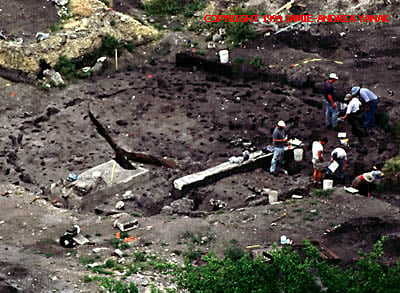

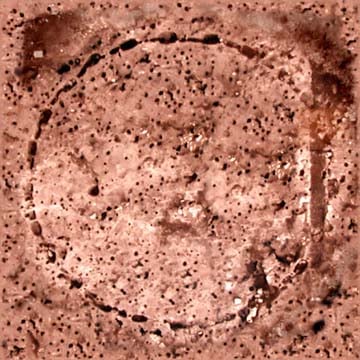

SITE PRESERVATION
Considering the amount of modern construction (and demolition) that has taken place on top of the site, the Miami Circle is remarkably intact -- with approximately 85% of it preserved. The Brickell Point property contains intact prehistoric midden deposits on at least 50% - 75% of the parcel. This material contains a tremendous quantity of well-preserved shell, bone, ceramics, and other artifacts deposited during several centuries of human occupation.
SITE ORIGINS
The "mainstream" opinion says "the Tequesta Indians," a group of Southern Florida native Americans who inhabited the area from about 2000 years ago to after the Spanish arrived -- spanning roughly the same dates as the artifacts recovered from the Cicle's "holes." A minority opinion (Riggs, Hoagland, et al) says MUCH older ... by a sophisticated people who lived here long before the Tequestas were in the area ... perhaps as much as 10,000 to 13,000 years ago.
SITE AGE
At present, two radiocarbon date determinations have been completed. Charcoal samples collected from within one of the Miami Circle's cut basins and from the midden within the Miami Circle both dated to circa 100 A.D. Human occupation of the site may date to well over two thousands years ago.
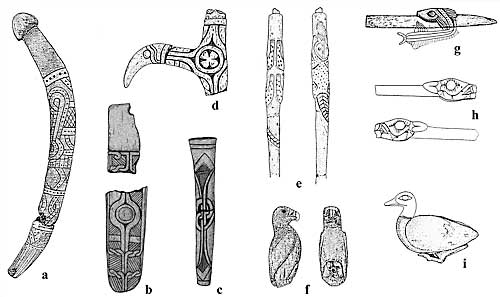

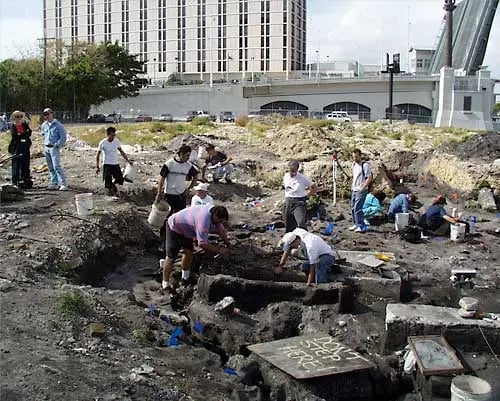


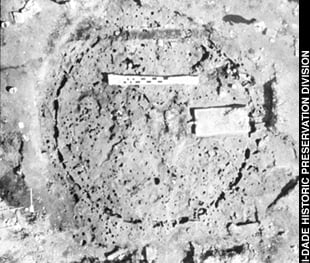
SITE SIGNIFICANCE
The Miami Circle archaeological site is regarded as being of local, regional, and statewide significance. The Miami Circle may also be of national significance, as it is believed to be the only cut-in-rock prehistoric structural footprint ever found in eastern North America. The site potentially qualifies for listing in the National Register of Historic Places. If we fail to preserve the Circle, a priceless , untouched example of a previously unsuspected sophistication in "archaic North American architecture," as well as important new clues as to the reasons for astronomically-based indigenous ceremonial centers will be lost. The Miami Circle, though architecturally unique (carved basins in the limestone bedrock), has at least one other potetially significant analog in North America: the ancient circle of wooden post holes -- called "Woodhenge 2" -- placed on the summit of a massive earthen "Indian Mound" known as "Cahokia," located across the river from St.Louis, Missouri.
SITE FUNCTION
Archaeological evidence suggests the Miami Circle marks the footprint [foundation] of a large, prehistoric structure, possibly the "foundations for a 'Coucil House,' or other ceremonial structure created by native Americans known as the Tequesta. The evidence also suggests that the Miami Circle had ceremonial importance to the Tequesta:
* Cardinal points (i.e. North, South, East, and West) along the Miami Circle appear to have been specially denoted. In particular, an eye-shaped hole was cut into the bedrock at the Circle's eastern point. Its shape was unique among hundreds of holes uncovered at the site.
* Two possible animal offerings, a complete sea turtle carapace and the articulated remains of a shark more than six feet in length, were found within the Circle's interior. Each was oriented east-west, a practice often associated with prehistoric human burials.
* Several teeth belonging to an extinct species of seal were found within the Miami Circle. Spanish explorer's accounts indicate that the consumption of monk seals, or "sea wolves," were reserved for the elite class.
* Two finely-crafted stone axes were found found along the Miami Circle's eastern portion. One of these was recovered from within a posthole cut into the bedrock, and possibly represents an offering. Both axes were made of basalt, a volcanic rock that is not native to Florida.
The minority scientists say that the structure's puzzling ring-shaped array of 30 rectangular "basins" are more analogous to England's "Stonehenge" -- once serving as the "foundation slots" for a ring of 30 upright stones, which once stood in the currently surviving geometric bedrock basins -"an archeo-astronomical "stonehenge-like device," for observing the solstices and equinoxes, as well as other astronomically-based ceremonial uses ..."
SITE STATUS
The Mayor of Miami-Dade County, the Honorable Alex Penelas, signed an "eminent domain decree" last February, setting in motion a legal process for County acquisition and preservation of the Miami River Circle site. An "eminent domain" trial is set to begin October 4th to decide the actual purchase price of the land. If the County cannot raise the necessary funds in time (the exact amount to be dermined by the jury), the land will then revert back to the developer: MIchael Baumann.. The County needs massive financial help, as the current "save the circle" fund is far short of even what the developer originally paid for the land.
The developer, Michael Bauman, originally paid slightly over 8 million dollars for the 2.2 acre site at the mouth of the Miami River. He is now claiming additional costs in architetural development, lost revenues due to the eminent domain proceeding, etc., totalling in excess of 50million dollars. Ultimately, based on evidence presented by the County and the developer at trial, a jury of twelve men and woman selected from the normal jury pool in the Miami area will decide what the Circle site is worth in today's market -- and award Mr.Baumann according compensation.
The state of Florida has offered 16 million dollars, or half the amount awarded to the developer, whichever is less.
SUPPORTERS FOR THE PRESERVATION OF THE CIRCLE
The Mayor of Miami-Dade County, the Honorable Alex Penelas, signed an "eminent domain decree" last February, setting in motion a legal process for County acquisition and preservation of the Miami River Circle site. An "eminent domain" trial is set to begin October 4th to decide the actual purchase price of the land. If the County cannot raise the necessary funds in time (the exact amount to be dermined by the jury), the land will then revert back to the developer: MIchael Baumann.. The County needs massive financial help, as the current "save the circle" fund is far short of even what the developer originally paid for the land.
The developer, Michael Bauman, originally paid slightly over 8 million dollars for the 2.2 acre site at the mouth of the Miami River. He is now claiming additional costs in architetural development, lost revenues due to the eminent domain proceeding, etc., totalling in excess of 50million dollars. Ultimately, based on evidence presented by the County and the developer at trial, a jury of twelve men and woman selected from the normal jury pool in the Miami area will decide what the Circle site is worth in today's market -- and award Mr.Baumann according compensation.
The state of Florida has offered 16 million dollars, or half the amount awarded to the developer, whichever is less.
KEY PLAYERS IN THIS UNFOLDING DRAMA
The current owner of the Brickell Point Development Company (and the Miami Circle property), seeking to build twin high-rise towers on the 2.2 acre site, is developer Michael Baumann. The discoverer of the Circle itself was professional surveyor and long-time amateur archeologist, T. L. Riggs. The former chief archaeologist for Miami-Dade County, and still Project Director for the Miami Circle excavation, is Bobb Carr (now Executive Director of the privately-funded Archaeological and Historical Conservancy). His former Miami-Dade assistant, archaeologist John Ricisak, is current Field Director of the Miami Circle excavation. Richard C. Hoagland, former NASA consultant and Science Advisor to Walter Cronkite and CBS News, and 1993 Angstrom Medal winner for Excellence in Science, has been leading the fight for preservation of the Circle. It was through his major media contacts and continuing efforts that national and international attention was first focused on the problem, leading to the political and courageous legal action to "save the circle" by Mayor Alex Penelas. Assisting Hoagland in these vigorous grassroots efforts was the well-known Native American activist, Robert Ghostwolf. Mark Diamond, a world-renowned photographer, was enlisted early-on by Hoagland to document in digital media the contnuing story of "the Circle"; his evocative 360-degree panoramas and individual stills have provided some of the more moving coverage. David Haylock, Director of VisionEarth Society, an award winning film producer, commited to the preservation and documentation of this Site- created and directs "Save The Circle.org" to continue the fight. And Kynthia, known for her pioneering work in extraterrestrial archeology with her stunning Mars Face Sculpture, is the Art Director of the Save the Circle campaign, building the webstite, creating the logo, and the educational PR materials.
"Save The Circle.org" is working closely not only with the Mayor's office of Miami-Dade County in its continuing efforts to Save The Circle, but private research and historical organizations in the Miami area as well. These include the Dade-Hetritage Trust, the largest "preservationist" membership organization in Miami-Dade County; the Archaelogical Society of Southern Florida, a long-standing membership scientific research organization; and the non-profit Archaeological and Historical Conservancy, now headed by Bob Carr, the senior scientist who formerly directed all investigation to date of the Miami Circle for Miami-Dade County.
Is The Miami Circle related with










